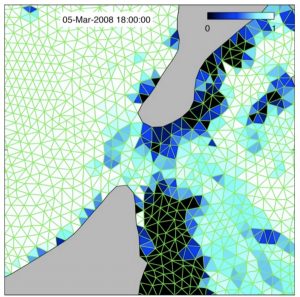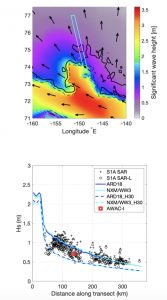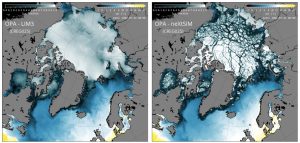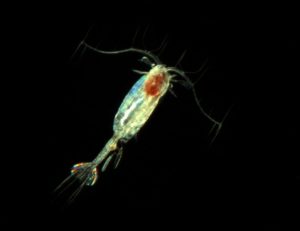WAVE-OCEAN-SEA-ICE INTERACTIONS IN THE ARCTIC
PI and organization: F. Ardhuin (LOPS, CNRS)
Co-Is: C. Lique (LOPS, IFREMER), P. Rampal (NERSC), T. Williams (NERSC), L. Brodeau (Ocean Next)
The Arctic environment is changing at an alarming and unprecedented rate. The most striking evidence is the large and fast shrinking and thinning of the sea ice pack that has accelerated recently. In addition to the potential far-reaching impacts on ocean circulation and climate, the transition to a seasonally ice-free Arctic allows new prospects for the socio- economic activities in the region. This emphasizes the need for the development of modeling platform able to simulate and forecast the short and long-term evolution of Arctic sea ice, and more generally the Arctic system.
The goal of this project is to improve the model representation and our understanding of the interactions between sea ice, ocean and wave at the Arctic ocean surface, with a particular focus on the Marginal Ice Zone (MIZ). To that aim, the Lagrangian sea ice model, neXtSIM, is coupled with an ocean model (NEMO) and a wave model (WAVEWATCH III), making use of the regional configuration CREG4 previously developed under the CMEMS’s umbrella. The novelty of neXtSIM lies within its ability to better reproduce the sea ice mechanical properties that the more classical sea ice models used within the scientific community. Its inclusion within a coupled modeling platform will have a positive impact on the representation of the ocean surface properties, as well as the interplay between sea ice and waves propagating into the sea ice pack.
Figure 1. Simulated concentration and the associated computational mesh used by neXtSIM. Due to strong winds at this point in the simulation the mesh is becoming relatively deformed along the coast in the figure’s upper right quadrant. This is subsequently addressed by inserting new triangles along the coast line, leaving the rest of the mesh intact.
The new modeling platforms have been used to perform simulations carefully compared against available observations, allowing a better understanding of the key processes that needs to be properly included in state-of-the-art ocean-sea ice-wave models in order properly simulate and forecast the evolution of the sea ice pack.
First, we investigated the interactions of surface ocean waves with sea ice. We focused on the evolution of sea ice after it has been fragmented by the waves. Fragmented sea ice is expected to experience less resistance to deformation. We reproduced this evolution using a new coupling framework between a wave model and the recently developed sea ice model neXtSIM. We find that waves can significantly increase the mobility of compact sea ice over wide areas in the wake of storm events.
Figure2. Simulated distributions of significant wave height (top) in the Beaufort Sea taken from the neXtSIM-WAVEWATCH3 simulation during a storm on 12th October at 17:00:00 GMT, and comparison against significant wave height estimated from Sentinel-1a SAR images (Ardhuin et al., 2018) and measured by an AWAC buoy (bottom).
Second, we investigated the interactions of the surface ocean properties with sea ice. neXtSIM is able to simulate sea ice leads and kinematic features that LIM3 is not. These features have a signature onto the mixed layer properties, and the heat flux through the lead.





